Introduction
Background
Moshing has been described as “a form of dancing involving intense and violent physical activity; slamming into other audience members and throwing mock punches and kicks.”Reference Kahn-Harris 1 Moshing occurs at live rock concerts, near the front of the stage, and also includes crowd surfing (concert-goers being passed over the heads of the crowd in the prone or supine position), stage diving (jumping from the stage into the crowd with the expectation that the crowd below the stage will catch you), pushing, and shoving.Reference Janchar, Samaddar and Milzman 2 , Reference Ambrose 3 This form of dancing started in California (USA) during the 1970s, becoming mainstream in the 1980s, to present day, where “almost any rock, punk, or heavy metal concert is not complete without such a mosh-pit. Whether it is inspired by the music or explicitly encouraged by the band, the mosh-pit is a central part of the concert experience to many fans.”Reference Ambrose 3 , Reference Stuckey 4 Moshing occurs in a “mosh-pit” and is a “tension between violence and order.”Reference Kahn-Harris 1 Patrons move in a “highly energized collective motion” that is similar to a “disordered gas-like state called a mosh-pit and an ordered vortex-like state called a circle pit.”Reference Silverberg, Bierbaum, Sethna and Cohen 5 Unlike a riot, where the balance has fallen to violence, moshing has rules, where the fallen are immediately picked up and overly violent audience members are ejected from the pit.Reference Kahn-Harris 1 , Reference Spencer 6 Due to the violent nature of mosh-pits and potential for injuries (including death, with 70 mosh-pit-related deaths between 1994 and 2006), controversy exists surrounding their existence at concerts, with some bands coming out against them and other bands encouraging them. 7 - Reference Fricke 14 Bands, venues, and promoters have all been subject to legal action due to mosh-pit-related injuries, and law firms have started soliciting for mosh-pit-injured clients.Reference Friedman 9 , Reference Hoffman 15 - 18
Goals of this Study
The goal of this study was to report epidemiologic information to quantify patient presentation rate (PPR), transport to hospital rate (TTHR), and injury patterns from patients who participated in mosh-pits at rock concerts. This information can then be used to explore ways to increase safety and security at rock concerts.
Materials and Methods
Subjects were those patrons who sought medical care presenting from the mosh-pit at a single venue. The events reviewed were two national concert tours which visited this venue as part of their tour. Tour dates were 2011-2014.
All data were collected retrospectively from prehospital patient care reports (PCRs). A single Emergency Medical Service (EMS) provided medical care at this venue for all reviewed tour dates. Staff from this agency were able to collect data by screening all PCRs from those dates. Any PCR attributing injury to participation in a mosh-pit was given to one of the investigators for further data abstraction. In addition, aggregate numbers for all patient presentations, whether from the mosh-pit or the general population, were provided for each event.
The following information was gathered from each PCR: type of injury, location of injury, treatment received, alcohol or drug use, Advanced Life Support/ALS interventions required, age and gender, disposition, minor or parent issues, as well as type of activity engaged in when injured.
All data were entered into a spreadsheet (Microsoft Excel, Microsoft Corporation; Redmond, Washington USA) for analysis. Some analyses were performed using SPSS Statistics (IBM Corporation; Released 2015. IBM SPSS Statistics for Windows, Version 23.0; Armonk, New York USA) and online statistical calculators (Stat Trek [online resource] and MedCalc [Ostend, Belgium]).
The study was reviewed and approved by the University of Massachusetts Medical School (Worcester, Massachusetts USA) Institutional Review Board.
Results
Eight distinct events were examined. The events occurred between 2011 and 2014. Attendance ranged from 5,100 to 16,000. Total patient presentations ranged from 50 to 206 per event. Patient presentations per ten thousand (PPTT) ranged from 56 to 130. The TTHR per 10,000 ranged from seven to 20. Table 1 displays the data by event. The mean PPTT was 99 (95% CI, 77-122) and the median was 98. The mean TTHR was 16 (95% CI, 12-29) and the median TTHR was 17.
Table 1 Patient Presentation and Transport Rates

Abbreviations: PPTT, patient presentations per ten thousand; TTHR, transfer to hospital rate.
As noted in Table 1, the rate of cases presenting from the mosh-pit area varied by event. The mean presentation rate was 26% of total cases (IQR 22%-37%). The median was 30%. Specific PPTT and TTHR for mosh-pit activities was not possible as the true denominators of those participating in mosh-pit activities were not discernible. Patients presenting from mosh-pits were more frequently male (145 out of 253; 57.6%; P<.004). The mean and median ages were 20 (95% CI, 19-20) and 19, respectively. Figure 1 displays the distribution of ages of patients presenting from mosh-pits. Patients under the age of 18 numbered 70 (28% of total mosh-pit patients).
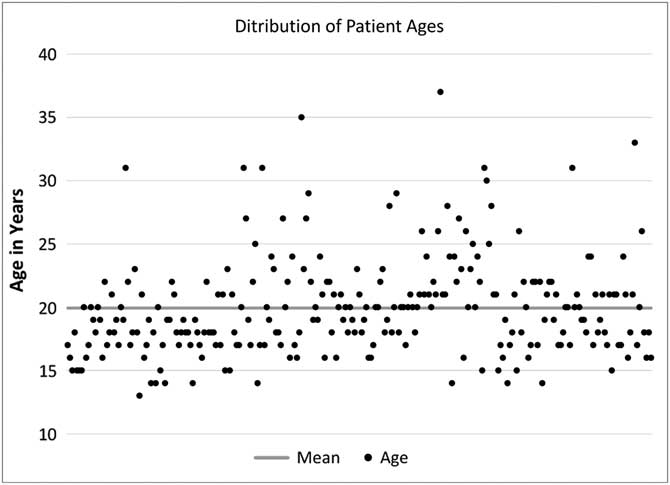
Figure 1 Distribution of Patient Ages.
Treatment received was overwhelmingly at the Basic Life Support (BLS) level (245 out of 253 cases; 96.8%; P<.000001). One case was evacuated by Helicopter EMS. One patient was released to police custody.
Injuries were categorized by mechanism and by the part of the body injured. Sixty-two percent were struck in some manner. Many of those listed as “other” were struck by missiles (thrown objects). The reporting of this was not adequately consistent to provide specific data. Mechanisms of injury may be seen in Table 2. Four patients admitted to or were confirmed to have used alcohol and one patient admitted to using recreational drugs.
Table 2 Injury Mechanism
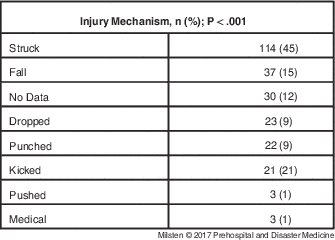
The activity in which the patient was engaged at the time of injury also was recorded. The results are listed in Table 3. The most common activity was general moshing. Crowd surfing was the next most significant contributor to injuries, accounting for 20% of presentations. The most common body part injured was the head with 64% of injuries. These injuries included 15 facial injuries and 16 eye injuries. Table 4 lists the details of body parts injured. Figure 2 shows the percentage of injuries to the main body part categories.
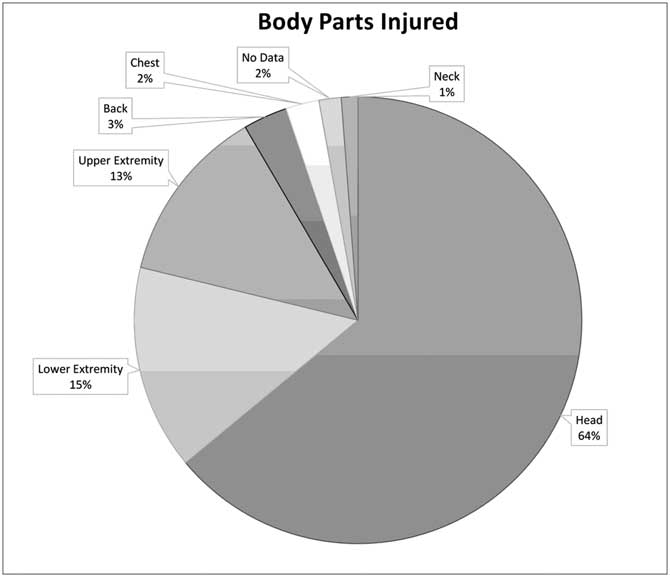
Figure 2 Body Parts Injured.
Table 3 Type of Activity Engaged in at Time of Injury
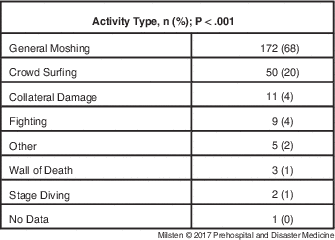
Table 4 Body Parts Injured
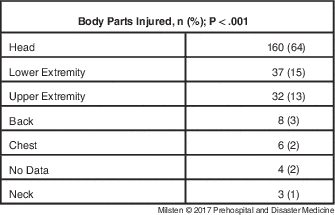
Discussion
This study found a similar PPTT and TTHR to the two other mosh-pit-only studies conducted in the past. From these studies, it can be said that the PPR for concerts with mosh-pits will be 50 to 206 PPTT. Furthermore, the TTHR will range from 3.9 to 23 PPTT. Because this study’s data were collected retrospectively, there are no outcome data for transported patients in this data set. So, it is not known how many of the patients sent to the hospital are treated/released versus admitted. Janchar found a hospital admit rate of 4.5 PPTT for mosh events.Reference Janchar, Samaddar and Milzman 19 In general, concerts with mosh-pits will have a much higher PPTT than other events. There can always be exceptions to the rule, such as the riot reported by Grange.Reference Grange, Green and Downs 20
This study found 57.6% male and 42.4% female patients, which is consistent with past studies. It is important to note, though, that the mean age of patrons in the mosh-pit was 20, with the youngest being 13 years old. Younger patients in mosh-pits (28% of all injured persons in this study were <18 years old) would seem to be more at-risk for injuries. The relative persons’ size compared to other patrons in the mosh-pit could lead to them being thrown higher while crowd surfing, and to potentially worse injuries on landing. However, this study’s data did not show this to be the case. Younger patients do presents challenges to the medical providers though, when it comes to disposition decisions, especially if the parents cannot be contacted.
Erickson studied five rock concerts in 1996 and found 48% of patrons who were specifically queried about ethanol (ETOH)/alcohol or illicit drug use admitted to the use of these substances.Reference Erickson, Aks, Koenigsberg, Bunney, Schurgin and Levy 21 In his study of California concerts, Grange found moderate levels of altered mental status in 79 patients at one heavy metal concert with ETOH/drugs playing a role 11% of the time.Reference Grange, Green and Downs 20 Other retrospective studies have found similar rates of alcohol and/or drug use (0.9% at Baltimore [Maryland USA] rock concerts, 1.3% at California rock festival, 3.4% at Canadian rock festival, and 8.0% at Watkins Glen [New York USA]).Reference Ounanian, Salinas, Shear and Rodney 22 - Reference Milsten, Seaman, Liu, Bissell and Maguire 26 In this study, an almost non-existent rate of reported alcohol and drug use was found. This is due to the retrospective nature of the study, and unless patrons seeking first-aid care are specifically asked about alcohol and drug use, the data obtained are unreliable. In a study of alcohol use at baseball games, an event considered more tame than most rock concerts (at least when looking at the PPR, which one study reported as 4.85 PPTT), 51% of fans (ages 20-35) walking around and not seeking first-aid care were positive for alcohol use.Reference Milsten, Seaman, Liu, Bissell and Maguire 26 , Reference Wolfe, Martinez and Scott 27 Whether that rate would be higher for a rock concert is unclear. This is an area for further study.
Mosh-pits certainly have the potential to increase injuries at rock concerts. Evidence of this has been reported in the lay-press and by event management companies that monitor injuries and promote concert safety. A 2002 review of 31 world-wide concerts indicated 20 concert-related deaths occurred over that year along with 4,567 injuries. The report also lists concert-related deaths from 1992-2002, with the peak number of deaths (70) occurring in 1999.Reference Wertheimer 13 US-based, main-stream media outlets have reported mosh-pit-related deaths across the United States for at least the last 20 years.Reference Friedman 9 , Reference Fricke 14 , Reference Pogrebin 28 - Reference Green 31
The medical academic literature has been less prolific than the lay-press on this subject. There have been a few studies looking at rock-concert-related injuries, including breast-related injuries; non-occupational, noise-induced hearing loss; and methaemoglobinaemia (from amyl nitrate abuse).Reference Drew 32 - Reference Wilkerson 34 Grange et al studied injuries at 85 California rock concerts over five years and found the highest number of patients and transports was at a heavy metal rock concert with mosh-pits (79 patients, eight transports; head lacerations 20%, lacerations and abrasions 26%, and extremity injuries 20%).Reference Grange, Green and Downs 20 Median PPTT for rock concerts was 13.7 compared to 7.1 PPTT for non-rock concerts. A punk concert had highest PPTT (71 PPTT) due to a riot. Overall, attendees at rock concerts were 2.5 times more likely of being evaluated at a first-aid station than attendees at non-rock concerts. The reason for this is multi-factorial and most likely includes: the presence of mosh-pits, increased crowd mobility associated with unreserved festival style seating, longer event duration, younger age, and possible substance abuse.Reference Milsten, Seaman, Liu, Bissell and Maguire 26
Janchar et al did a direct comparison of four mosh-pit concerts to six non-mosh-pit concerts.Reference Janchar, Samaddar and Milzman 2 They reported a higher PPR at mosh-pit concerts (61.1 PPTT versus 7.6 PPTT for non-mosh events). Of the mosh-related injuries, 37% were either lacerations or musculo-skeletal. Events with mosh-pits had higher TTHRs as well, 1.5 TTHR for mosh-pits versus 0.2 TTHR for non-mosh events (with 74% of transports from mosh-pit events being related to mosh-pit injuries). These PPRs were similar to those reported by Milsten et al in a study including 21 concerts that found a single mosh-pit event’s PPTT to be much higher than events without mosh-pits (110 PPTT compared to 7.5 PPTT).Reference Milsten, Seaman, Liu, Bissell and Maguire 26
Janchar et al conducted a follow-up study that looked at 10 years of data from a single, large, outdoor, multi-purpose stadium which seated 62,000 persons for concerts.Reference Janchar, Samaddar and Milzman 19 In this study of nine different mosh events, the combined PPTT was 85.5 and TTHR was 3.9. Hospital transports were 17 times greater at mosh events and standard in-seat (non-mosh) event PPTT was 9.0. Patients coming from the mosh-pit were more severely injured with traumatic injuries being 11 times greater at mosh events and hospital admits were 15 times higher. Of patrons visiting the first-aid station at mosh concerts, 33% of total patients (26 PPTT) were seen for injuries directly related to moshing. Of these, 17% were for lacerations and abrasions and 20% for musculo-skeletal trauma. Hospital admits were 4.5 PPTT for mosh events compared to 0.3 PPTT for in-seat events.
The authors of this study theorize that in most rock concerts, especially festival type of events with a younger audience, energy drink intake may be more prevalent than alcohol use. This would seem especially true at events sponsored by energy drink companies, such as the two events analyzed in this study.Reference Andrews 35 A 2007 North Carolina (USA) study of college-age students found 51% consume more than one energy drink a month, and 2013 Red Bull dollar sales of energy drink beverages and shots in the US reached over $12 billion (USD).Reference BM and VG 36 , 37 Concert attendees are often not allowed to bring in their own beverages for a variety of reasons, one being that these bottles can then be thrown as missiles.Reference Hewitt, Jarrett and Winter 38 However, given the cursory bag searches conducted at entrances, many substances are smuggled into and around concerts.Reference Bain 39 , Reference Bain 40 Given the younger age of patrons at rock concerts, it follows that less alcohol would be sold as compared to a sporting event.
As with other studies, 62% of patient presenting for first-aid were mostly minor, trauma-related, requiring BLS level of care. This is not surprising, given the violent nature of mosh-pits (Table 3 shows location of injuries). Sixty-four percent of injuries were to the head and neck, and this was mostly due to being struck and crowd surfing. The Oxford online dictionary defines crowd surfing as “Be passed in a prone position over the heads of the audience at a rock concert, typically after having jumped from the stage.” 41 This definition does not tell the real potentially violent story of crowd surfing, where:
People around you lift you up onto the heads of the crowd around you. Then either all the people holding you up slowly pass you around or they all at once throw you to another section of the crowd. Usually the ride ends with security pulling you down and then you have to go to the back of the crowd and work your way back up to where you started from. Or the people you are passed to do not know you are coming and end up dropping you. The crowd surfing was so cool, until I got dropped on my head. 42
In this study, crowd surfing was a particularly common cause of injuries with 20% of injuries, leading to potentially devastating head- and neck-related injuries. Collateral damage is another important and often overlooked factor. Patrons on the periphery of a mosh-pit have an important role, but are also in danger of injury.Reference Spencer 6 This study found four percent of injuries were from collateral damage.
Since it can be seen that having mosh-pits at a concert increases patron injuries, it makes sense to look at mitigation and preparation methods that can counteract that factor. Fried conducted a 155-person fan safety survey in 2012 that found 22% of responders had felt threatened or intimidated at a concert and 18% had been involved in a verbal or physical altercation.Reference Fried 43 The 2015 Paris (France) terrorist attacks have added a heightened sense of urgency and need to increase safety at concert venues.Reference Knopper 44 There has been a lot of work in this area, though mostly having to do with general crowd management principles for non-concert events. In 2008, a temporary employee of Wal-Mart (Bentonville, Arkansas) was crushed to death during a “Black Friday” holiday shopping sale. These annual sales are de rigueur for large retailers and include large crowds waiting in long lines (often camping out the night before), “mayhem marketing,” a competitive atmosphere for discounted items, and very little crowd management training for staff.Reference Wertheimer 45 This combination of factors lead to the 2008 Wal-Mart death, subsequent $7,000 fine, and rulemaking undertaken by Occupational Safety and Health Administration (OSHA; Washington, DC USA) and the National Retail Federation (Washington, DC USA; US-based agency).Reference Seabrook 29 , Reference Wertheimer 45 - 48 Wal-Mart spent millions of dollars fighting this ruling over the past eight years, but finally lost in 2015.Reference Woolhouse 46
Even though the OSHA regulations for crowd management were written for employers, who are responsible for providing a safe workplace, pieces of these guidelines can be used to mitigate against mosh-pit-related injuries. This includes basic items such as hiring additional staff, including trained security or crowd management personnel; having a detailed staffing and crowd management plan; and making sure the event meets all local public safety requirements.Reference USDoLOSH 47 There are concert-specific mitigation techniques as well, such as local governmental bans on unreserved festival seating in many locations (The North American Concert Promoters Association [Mclean, Virginia USA] reported that 10%-20% of concerts with more than 10,000 people still use festival seating). This change started slowly after 11 concert-goers were crushed trying to enter a Cincinnati, Ohio (USA) coliseum to see the Who (December 1979).Reference Seabrook 29 , Reference Wertheimer 49 - Reference Staff 51 Despite some cities banning festival seating, the practice continues and has led to crowd-related crush injury deaths.Reference DeBarros 8 , Reference Wertheimer 49 , Reference Phillips 52 More recently, though, the US National Fire Protection Agency (NFPA; Quincy, Massachusetts USA) has issued updated Life Safety and Building Codes (NFPA 101 and NFPA 5000) that require the presence of a trained crowd manager for all gatherings (except religious services) and prohibit festival seating for crowds of more than 250, unless a life-safety evaluation approved by the authority having jurisdiction has been performed. 53
There have been even more specific mosh-pit-related guidelines published, which include isolating mosh-pits from the general audience, limiting their capacity and density, banning stage diving, and providing clear safety signage and announcements.Reference Stuckey 4 , Reference Spencer 6 , Reference Wertheimer 54 Social media has also put forth mosh-pit “rules” that include advice about what clothing is safe, knowing what type of mosh-pit you are in (the slam pit, the circle pit, the thrash metal pit, the death metal pit, the black metal pit, the punk pit, the alternative pit, the swaying pit, the power metal pit, the wall of death pit, or the hardcore pit), and other general etiquette rules.Reference Metal 55 , 56 Security personnel and concert promoters may film mosh-pits, both for patron safety (to spot “moshers who are out of control”) and to preempt potential legal action by making a video record.Reference Ferman 57
Limitations
This study had several limitations. The most notable was that these data were gathered from a single venue with a limited number of concerts. While researchers can gather more complete data from an EMS agency with which they have a good working relationship, the single venue can limit the number of and variety of mosh-pits available for data gathering. The limited number of concerts also affects overall numbers as more concerts and more mosh-pits allow for potentially more patients, and again, more data.
This was also a retrospective study which obtained data after the concerts took place. Although this could be considered a limitation, it is unclear that this aspect of the design actually affected results since the goal was to describe and quantify the injuries seen and no intervention was applied.
Lastly, although the number of patients transported to the hospital could be determined, there was no outcome data for those who were transported. This limited the ability to determine the severity of injuries and further refine categorization.
Going forward, the authors recommend following up this study with a comprehensive review of several different kinds of venues that hold a larger number of concerts to build a more comprehensive database of mosh-pit injuries.
Conclusions
The data obtained from this retrospective review of mosh-pit-associated injury patterns demonstrate a high rate of injuries and presentations to medical aid for the evaluated events. General moshing was the most commonly associated activity and the head was the most common body part injured.
Acknowledgement
The authors would like to thank David Piantedosi, NREMTP, owner of Events EMS (Medway, Massachusetts USA), for his invaluable contribution to this manuscript.








